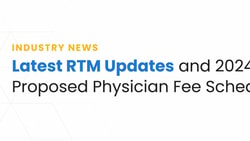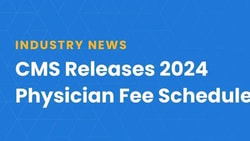New Digital Health Opportunities in the 2026 Proposed Physician Fee Schedule
The 2026 Proposed Physician Fee Schedule introduces exciting new billing opportunities for RTM and value-based care. Here's what you need to know.
August 6, 2025
5 min. read
.jpg)
The 2026 Proposed Physician Fee Schedule from the Centers for Medicare & Medicaid Services (CMS) represents an incredibly exciting opportunity for PTs, OTs, SLPs, and other disciplines remotely monitoring their patients.
CMS has added two new remote therapeutic monitoring (RTM) codes intended to increase the flexibility of the service for the provider and ease many of the operational challenges that have hindered adoption of remote monitoring for many clinics. The Proposed Rule also offers new opportunities for organizations engaged in value-based care with a new payment incentive for alternative payment models (APMs) and a new model for low back pain (LBP).
Let’s jump in and take a look at this huge (1,803 pages long!) action-packed rule.
CMS Expands Remote Therapeutic Monitoring with Two New CPT Codes
As expected, two new codes will join the existing four RTM codes used for musculoskeletal monitoring. Surprisingly, CMS is proposing the same payment levels as their higher engagement counterparts, stating, “We are proposing the same valuation for both CPT codes 98XX5 and 98977 since the device is supplied to the beneficiary for the full 30-day period, regardless of the number of days that data is transmitted.”1
If finalized, CMS will pay clinicians the same rate regardless of the amount of engagement from the patient. This makes sense, since the cost to the provider will be the same whether the patient logs in two times or 16 times.
The new code descriptions are:
98XX5: Remote therapeutic monitoring (e.g. therapy adherence, therapy response, digital therapeutic interventions); device(s) supply for data access or data transmissions to support monitoring of musculoskeletal system, 2–15 days in a 30-day period.
98XX7: Remote therapeutic monitoring treatment management services, physician or other qualified health care professional time in a calendar month requiring at least one real-time interactive communication with the patient or caregiver during the calendar month first 10 minutes.2
Although CMS did not adopt the Relative Value Scale Update Committee (RUC)’s recommendation to increase the Relative Value Units (RVUs) for the existing code, it’s encouraging that the agency responded to rehab therapy advocates and proposed a solution to the arbitrary 16-day and 20-minute thresholds currently in place. Now is the time to recognize this progress and support it by submitting a comment on the proposed rule. Because these policies are not yet final, public feedback remains critical.
CMS indicates in the rule that the RTM family of codes is considered new technology and will be placed on the New Technology List to be re-evaluated in April 2030 after utilization data has been gathered.3
Update (October 2025): Understand Medicaid Payment Rates for RTM
The American Physical Therapy Association (APTA) recently released its State Medicaid Payment Rate Guide. We highly recommend members review the resource to gain a better understanding of Medicaid rates in your state. For organizations looking to expand their reach across more payers and more states, this report is a key resource to facilitate growth in 2026.
According to the guide, which details Medicaid rates for all CPT codes relevant for physical therapy, the following 25 states reimburse for RTM: Arizona, Colorado, Connecticut, Delaware, Georgia, Hawaii, Indiana, Iowa, Kentucky, Maine, Massachusetts, Michigan, Minnesota, Mississippi, Missouri, Montana, Nebraska, New Jersey, New Mexico, North Carolina, Ohio, Rhode Island, Utah, Virginia and Wyoming.
Get in touch with us to learn about how Medbridge can support your new RTM service today!
Value-Based Care Moves Ahead
CMS has introduced a two-tiered conversion factor: 3.8 percent for qualifying alternative payment model (APMs) participants and 3.3 percent for non-QPs. Most PTs, OTs, and SLPs will be non-QP due to an inability to participate in APMs.
The American Physical Therapy Association (APTA) notes that the adjustment to the Physician Fee Schedule is positive for physicians due to the new conversion factor, but that PTs may see a decrease in reimbursement due to changes to the RVUs.
CMS is proposing an “efficiency adjustment” to non-time based codes. Unfortunately, it seems that CMS has misapplied the adjustment to several PT time-based codes as well, and APTA has sent a letter to CMS seeking clarification.4
New Alternative Payment Model for Low Back Pain (LBP)
CMS has introduced a new alternative payment model named the Ambulatory Specialty Model, focused on low back pain and congestive heart failure. The model aims to improve prevention and management of chronic disease with the intention of preventing hospitalization and unneeded procedures, and reducing costs.
If finalized, the model would begin January 1, 2027, and run for five performance years through the end of 2031. Unfortunately, in its current state, the model is only available to physicians and not to rehab therapy, but perhaps that could change with enough comments and advocacy before the model takes effect. More information on the model is available at the CMS homepage.
For more information on the proposed rule, we recommend that providers review the Proposed 2026 Physician Fee Schedule at the Federal Register, the Fact Sheet, and APTA’s analysis. Comments on the rule are due by Sept. 12, 2025.





